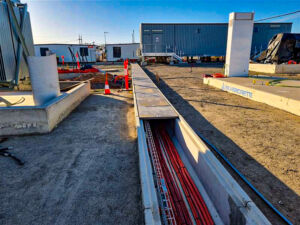As Australia’s renewable energy sector continues to grow, the role of Battery Energy Storage Systems (BESS) is becoming increasingly vital to grid stability. These systems help manage the intermittent nature of renewable energy sources like solar and wind, ensuring a continuous and reliable power supply.
However, as the demand for cleaner energy solutions rises, so too does the need for more efficient, safer, and cost-effective infrastructure to support these systems.
Traditional materials, such as steel and concrete, have long been the go-to options for components like trench covers and protective lids in energy storage systems. While these materials have served their purpose, they are not well suited to meet the evolving demands of modern energy storage infrastructure. They are heavy and difficult to manoeuvre, increasing OH&S risks, reducing ease of access, and slowing down maintenance. They can also interfere with radio frequencies and generate harmonics – compromising the performance and reliability of wireless monitoring and control systems essential to BESS operations.
So how do you optimise energy storage systems for safety, efficiency and performance while keeping your installation and operational costs down?
The Current Challenges of BESS
Working with traditional materials like steel and concrete presents several challenges in the deployment and maintenance of energy storage systems:
- Weather conditions can cause performance degradation, like corrosion, and increase maintenance needs, especially in outdoor settings.
- Labour shortages and rising skilled labour costs can make installations and ongoing maintenance more expensive and difficult to execute efficiently.
- Installation costs are higher due to the time, labour, and OH&S risks associated with handling heavy materials.
- Ensuring that BESS installations meet safety standards is critical. These systems require materials that are not only durable but also fire-resistant and non-conductive to reduce the risk of electrical hazards and ensure worker safety.
- Steel and concrete can cause radio interference, complicating wireless communication and monitoring systems.

The Non-Conductive Solution: FRP Composites in BESS
Terra Firma’s composite trench covers eliminate these challenges. The lightweight, corrosion-resistant properties of Fibreglass Reinforced Plastic (FRP) allow for faster, safer installations, reducing labour costs and minimising the need for frequent replacements or repairs. Here’s how FRP addresses the key issues:
- Lightweight and anti-slip: Reduced OH&S risks during installation, inspection and maintenance.
- Radio transparent: FRP doesn’t interfere with wireless monitoring or communication systems used in BESS facilities.
- Lower lifecycle costs: Minimal maintenance, fast installation, labour savings, durability and sustainability lead to savings on long-term expenses.
- Chemical and fire resistance: BAL40 rated and suitable for harsh environments.
- , warp or degrade in harsh outdoor conditions and isn’t affected by chemicals commonly found in civil infrastructure environments. This allows for easy and safe access during regular inspections, reducing the associated risks and downtime.
- Non-conductive properties: Provides electrical insulation for worker protection and enhanced safety.
- Strong and durable: With load ratings from B to D-class, it protects sensitive equipment, ensuring its safety from potential damage.
Case Study: Broken Hill Battery Energy Storage System
The Broken Hill BESS faced several challenges typical of energy storage systems relying on traditional materials. The installation of heavy, rust-prone steel and concrete trench covers had led to safety concerns and maintenance delays, which negatively impacted the facility’s operational efficiency. Traditional lids can corrode into place making opening and inspecting difficult, dangerous and time-consuming. So, the decision was made to switch to FRP composite trench covers, providing several distinct advantages:
- Lightweight and safe: With trench access required regularly for inspections and cable upgrades, FRP allows one person to safely remove covers, cutting labour costs and significantly reducing OH&S risks.
- Non-conductive and radio transparent: The covers remove the need for grounding and support uninterrupted wireless communication – ideal for high-voltage environments.
- Rust-free and reliable: Unlike traditional steel lids, FRP covers don’t seize or corrode shut, ensuring easy access even after long periods between maintenance checks.
- Customisable for complex layouts: FRP can be easily manufactured to suit unique trench configurations, including corners, tight spaces and building integrations.
- Lower maintenance over time: High durability in harsh outdoor conditions reduced long-term upkeep and replacement needs.

Maximise BESS Performance and Minimise Costs with Terra Firma
As demand for renewable energy and energy storage grows, FRP composites will continue to play a key role in creating safer, more efficient, and cost-effective systems.
By ensuring that systems operate safely, effectively and without signal interference, our trench covers help maintain optimal communication and monitoring performance, ultimately adding value and reliability to BESS facilities.
Beyond pit lids and composite trench covers, Terra Firma offers other FRP infrastructure solutions, including stairs, platforms, and walkways. These modular, lightweight components integrate seamlessly into BESS projects, providing a flexible and cost-effective way to ensure worker safety, performance, and efficiency.
Discover how Terra Firma’s safe and smart FRP solutions are transforming energy infrastructure across Australia – and see the results for yourself in our real-world case studies.
Share this
Discover the Terra
Firma difference
Learn how we can help support your next project